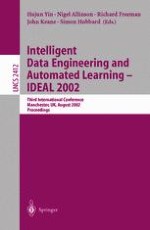2002 | Buch
Intelligent Data Engineering and Automated Learning — IDEAL 2002
Third International Conference Manchester, UK, August 12–14, 2002 Proceedings
herausgegeben von: Hujun Yin, Nigel Allinson, Richard Freeman, John Keane, Simon Hubbard
Verlag: Springer Berlin Heidelberg
Buchreihe : Lecture Notes in Computer Science
Enthalten in: Professional Book Archive
